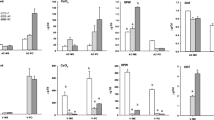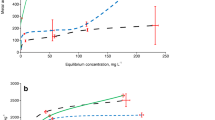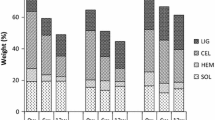Abstract
Purpose
Metal distribution patterns among geochemical fractions are informative for metal phytoavailability. Compost added to polluted soils may adsorb metals on the less phytoavailable fractions. A bioassay experiment was conducted to establish possible correlations between metal concentrations in different soil fractions and metal contents in edible plant parts and to investigate the influence of different compost loads on heavy metal availability to plants.
Materials and methods
Chinese cabbage plants were grown in pots with sandy and clayey soils and soils mixed with different doses of biosolid compost spiked with soluble heavy metal salts (Cd, Cu, and Pb). The metals’ distribution pattern in the soil and mixed samples was determined by sequential extraction procedure (modified BCR protocol). The studied fractions, from most to least bioavailable, were water-extractable (WE), exchangeable-adsorbed (EXC), associated with carbonates and acetic acid-soluble forms (CARB), occluded by reducible (hydro)oxides of Fe and Mn (RO), and associated with organic matter (OM) and a residual fraction (RES). Metal concentrations in soil extracts and in the digested plant tissue were measured by ICP-AES.
Results and discussion
The highest compost doses (72 and 115 Mg ha−1) enhanced cabbage yield significantly. No excessive phytoaccumulation of metals was observed in plants grown in the clayey soil or its mixtures with compost. The compost dose of 72 Mg ha−1 was optimal in decreasing Cu accumulation by plants grown in sandy soil, and 28.8 Mg ha−1 was found to be effective in reducing Cd and Pb uptake. Metals were accumulated in plants primarily from the WE, EXC, and CARB fractions, whereas other fractions decreased phytoaccumulation. Compost addition suppressed heavy metal mobility, but different fractions were active in pollutant sorption, depending on soil type and metal.
Conclusions
Compost addition increased metal proportions in the RO and OM fractions, reducing metal phytoavailability. This is especially important for sandy soils with low adsorption ability and higher vulnerability to metal pollution than clayey soils. A compost dose of 20% v/v (or 28.8 Mg ha−1) effectively reduced plant accumulation of Cd and Pb. We propose using the first three steps of the modified BCR protocol as a three-step sequential-extraction procedure for the most phytoavailable fractions of heavy metal: WE, EXC, and CARB.


Similar content being viewed by others
References
Alvarez EA, Mochon MC, Sanchez JC, Rodriguez MT (2002) Heavy metal extractable forms in sludge from wastewater treatment plants. Chemosphere 47:765–775
Basta NT, Ryan JA, Chaney RL (2005) Trace element chemistry in residual-treated soil: key concepts and metal bioavailability. J Environ Qual 34:49–63
Chen Y, Inbar Y, Barak P (1991) Soil testing methods (in Hebrew). Hebrew University of Jerusalem, Rehovot
EPA Method 3052 (1996) Microwave assisted acid digestion of siliceous and organically based matrices. http://www.epa.gov/osw/hazard/testmethods/sw846/pdfs/3052.pdf. Accessed 22 Sept 2011
EPA Method 6010c (2007) Inductively coupled plasma–atomic emission spectrometry. http://www.epa.gov/osw/hazard/testmethods/sw846/pdfs/6010c.pdf. Accessed 24 Aug 2010
Gat P (2006) The effect of dissolved organic matter (DOM) originating from biosolid on metals binding, solubilization and uptake by plants. Dissertation, Hebrew University of Jerusalem, Rehovot
Gleyzes C, Tellier S, Astruc M (2002) Fractionation studies of trace elements in contaminated soils and sediments: a review of sequential extraction procedures. Trends Anal Chem 21:451–467
He ZL, Yanga XE, Stoffellab PJ (2005) Trace elements in agroecosystems and impacts on the environment. J Trace Elem Med Biol 19:125–140
Israel Ministry of Environmental Quality (2005) Regulations for the treatment of soils polluted with heavy metals (in Hebrew). Tel-Aviv, Israel
Kabata-Pendias A, Pendias H (2001) Trace elements in soils and plants. CRC LLC, London
Kukier U, Chaney RL, Ryan JA, Daniels WL, Dowdy RH, Granato TC (2010) Phytoavailability of cadmium in long-term biosolids-amended soils. J Environ Qual 39(2):519–530
McLean JE, Bledsoe BE (1992) Behavior of metals in soils. EPA Ground Water Issue, EPA/540/S-92/018
Pueyo M, Rauret G, Luck D, Yli-Halla M, Muntau H, Quevauviller P, Lopez-Sanchez JF (2001) Certification of the extractable contents of Cd, Cr, Cu, Ni, Pb and Zn in a freshwater sediment following a collaboratively tested and optimised three-step sequential extraction procedure. J Environ Monit 3:243–250
Quevauviller P (1998a) Operationally defined extraction procedures for soil and sediment analysis. I. Standardization. Trends Anal Chem 17:289–298
Quevauviller P (1998b) Operationally defined extraction procedures for soil and sediment analysis: II. Certified reference materials. Trends Anal Chem 17:632–642
Quevauviller P (2002) Operationally defined extraction procedures for soil and sediment analysis. III. New CRMs for trace-element extractable contents. Trends Anal Chem 21:774–785
Sahuquillo A, Rigol A, Rauret G (2003) Overview of the use of leaching/extraction tests for risk assessment of trace metals in contaminated soils and sediments. Trends Anal Chem 22:152–159
Singer A (2010) The soils of Israel. Springer, Berlin
SK-12 Medium Pressure Rotor Application Book (2011) Milestone Srl, Italy. http://www.milestonesrl.com/analytical/customer-care-library-digestion.html
Tandy S, Healey JR, Nason MA, Williamson JC, Jones DL (2009) Remediation of metal polluted mine soil with compost: co-composting versus incorporation. Environ Pollut 157:690–697
Zmora-Nahum S, Hadar Y, Chen Y (2007) Physico-chemical properties of commercial composts varying in their source materials and country of origin. Soil Biol Biochem 39:1263–1276
Author information
Authors and Affiliations
Corresponding author
Additional information
Responsible editor: Claudio Bini
Rights and permissions
About this article
Cite this article
Rosen, V., Chen, Y. The influence of compost addition on heavy metal distribution between operationally defined geochemical fractions and on metal accumulation in plant. J Soils Sediments 14, 713–720 (2014). https://doi.org/10.1007/s11368-013-0819-7
Received:
Accepted:
Published:
Issue Date:
DOI: https://doi.org/10.1007/s11368-013-0819-7




